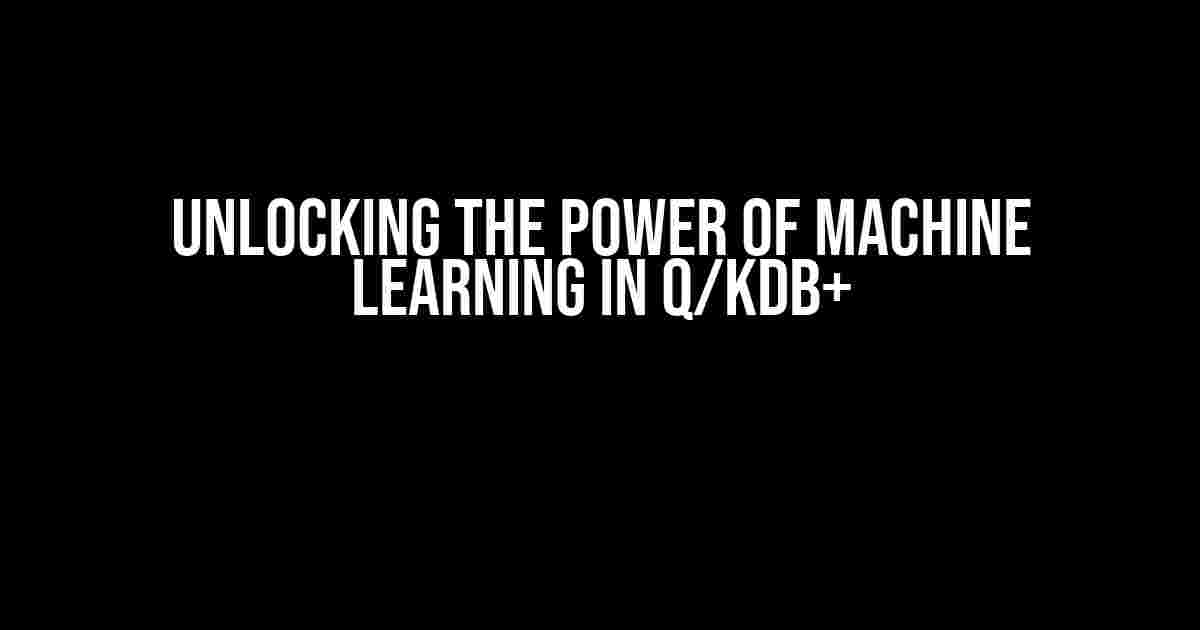Machine learning in q/kdb+ is a game-changer for data analysis and processing. With the ability to handle large datasets and perform complex calculations at incredible speeds, q/kdb+ is the perfect platform for implementing machine learning algorithms. In this article, we’ll delve into the world of machine learning in q/kdb+, exploring its benefits, key concepts, and step-by-step guides to get you started.
What is q/kdb+?
q/kdb+ is a high-performance programming language and database specifically designed for handling and analyzing large datasets. Developed by Kx Systems, q/kdb+ is widely used in the financial industry for trading, risk management, and data analysis. Its unique features, such as column-store architecture and in-memory processing, make it an ideal platform for machine learning applications.
Benefits of Machine Learning in q/kdb+
Machine learning in q/kdb+ offers several benefits, including:
- Speed and Efficiency: q/kdb+ can process large datasets at incredible speeds, making it perfect for real-time machine learning applications.
- Scalability: q/kdb+ can handle massive datasets with ease, making it an ideal choice for big data analysis.
- Low Latency: q/kdb+ provides low-latency data access and processing, ensuring timely insights and decision-making.
- Integration with Existing Systems: q/kdb+ can seamlessly integrate with existing systems and infrastructure, reducing implementation costs and complexity.
Key Concepts in Machine Learning
Before diving into machine learning in q/kdb+, it’s essential to understand the key concepts involved:
Supervised Learning
In supervised learning, the machine learning algorithm is trained on labeled data to learn patterns and relationships. The goal is to make predictions on new, unseen data based on the learned patterns.
Unsupervised Learning
In unsupervised learning, the machine learning algorithm is trained on unlabeled data to identify patterns and relationships. The goal is to discover hidden structures or clusters in the data.
Neural Networks
Neural networks are a type of machine learning algorithm inspired by the human brain. They consist of interconnected nodes (neurons) that process and transmit information.
Implementing Machine Learning in q/kdb+
Now that we’ve covered the basics, let’s dive into implementing machine learning algorithms in q/kdb+.
Installing Required Libraries
To get started with machine learning in q/kdb+, you’ll need to install the required libraries:
q) \l ml.q
q) \l stats.q
Loading Data
Load your dataset into q/kdb+ using the following syntax:
q) data: load "data.csv"
Preprocessing Data
Preprocess your data using various q/kdb+ functions:
q) data: data[; `date`time] / convert date and time columns to q temporal types
q) data: data[; ` close`: close % 100] / normalize close prices
Feature Engineering
Perform feature engineering using q/kdb+ functions:
q) data: data[; `moving_avg`: movavg close 20] / calculate moving average
q) data: data[; `std_dev`: stddev close 20] / calculate standard deviation
Training and Testing Models
Split your data into training and testing sets:
q) train: data[; 0.8 * count data]
q) test: data[; (0.8 * count data) + 1]
Train a simple linear regression model using the `ml` library:
q) model: ml.linear_regression[train; `close; `open`high`low]
Evaluate the model using mean squared error (MSE):
q) mse: ml.mse[test; `close; model]
Visualizing Results
Visualize your results using q/kdb+ plotting functions:
q) plot data[; `close; `open`high`low]
| Column | Type | Description |
|---|---|---|
| close | float | Closing price |
| open | float | Opening price |
| high | float | Highest price |
| low | float | Lowest price |
Best Practices for Machine Learning in q/kdb+
When working with machine learning in q/kdb+, keep the following best practices in mind:
- Data Quality: Ensure your data is clean, consistent, and well-formatted.
- Feature Selection: Select relevant features that impact your model’s performance.
- Model Evaluation: Evaluate your model using various metrics to ensure its accuracy and reliability.
- Hyperparameter Tuning: Tune hyperparameters to optimize your model’s performance.
- Model Ensemble: Combine multiple models to improve overall performance and reduce overfitting.
Conclusion
Machine learning in q/kdb+ offers unparalleled speed, scalability, and efficiency for data analysis and processing. By following the instructions and best practices outlined in this article, you’ll be well on your way to unlocking the power of machine learning in q/kdb+.
Remember to stay creative, experiment with different algorithms and techniques, and continuously evaluate and improve your models. Happy coding!
Frequently Asked Question
KDB+ is a high-performance database and analytics engine, and machine learning is a key aspect of its capabilities. Here are some frequently asked questions about machine learning in q/kdb+:
Can I use kdb+ for machine learning?
Absolutely! kdb+ is designed to handle large amounts of data and perform complex data analysis, making it an ideal platform for machine learning. You can use kdb+’s q language to implement machine learning algorithms, integrate with popular ML libraries, and even deploy models in production.
What kind of machine learning models can I build in kdb+?
The possibilities are endless! With kdb+, you can build a wide range of machine learning models, including regression, classification, clustering, decision trees, random forests, and even neural networks. kdb+’s q language provides an efficient way to implement these models and integrate them with your data pipeline.
How do I integrate kdb+ with popular machine learning libraries?
Easy peasy! kdb+ provides integrations with popular machine learning libraries like TensorFlow, PyTorch, and scikit-learn, allowing you to leverage their capabilities while maintaining the performance and scalability of kdb+. You can use APIs, libraries, and even custom interfaces to connect kdb+ with your favorite ML libraries.
Can I use kdb+ for real-time machine learning?
Yes! kdb+ is designed for real-time data processing and analysis, making it an ideal platform for real-time machine learning. You can use kdb+ to ingest and process streaming data, train models in real-time, and deploy them in production to make predictions and take actions.
What kind of data can I use for machine learning in kdb+?
Any data, anywhere! kdb+ supports a wide range of data sources, including relational databases, NoSQL databases, files, and even messaging systems. You can ingest and process structured, semi-structured, and unstructured data, and use it to train and deploy machine learning models.
